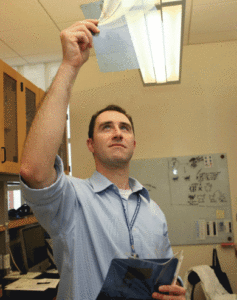 “There’s no one way to select candidates for active surveillance,” says urologist and molecular biologist Chris Barbieri, M.D., Ph.D., of Weill Cornell Medical College/New York Presbyterian Hospital. In addition to doing molecular research on prostate cancer, he treats men with all kinds of prostate cancer and works with several hundred patients currently on active surveillance.
“There’s no one way to select candidates for active surveillance,” says urologist and molecular biologist Chris Barbieri, M.D., Ph.D., of Weill Cornell Medical College/New York Presbyterian Hospital. In addition to doing molecular research on prostate cancer, he treats men with all kinds of prostate cancer and works with several hundred patients currently on active surveillance.
Some hospitals have very specific criteria. For example, at Johns Hopkins, men selected for the active surveillance program are considered “very low-risk.” These men have Gleason score 6 cancer in no more than two biopsy cores; in each of these cores, cancer is present in half or less; their PSA density (PSA divided by prostate volume; this can be helpful if a man has benign prostate enlargement, or BPH, which is a separate prostate problem and is not cancer) is 0.15 or less; and they have no cancer that can be felt on a rectal exam. Other men in the Hopkins program have “low-risk” cancer: no cancer that can be felt on a rectal exam, a PSA below 10, and Gleason 6 cancer on their biopsy. All men are monitored faithfully, with regular follow-up visits and yearly biopsies, although recent studies suggest that some men can still be safely monitored with a longer interval between biopsies.
Other hospitals take it more on a case-by-case basis. The truth, says Barbieri, is that “nobody knows the perfect way to do this. There are many hospitals where physicians are taking very reasonable approaches,” even if they differ on the exact specifics. “The principle is that it’s for men with a low volume of disease, and a low grade of cancer.” However, he adds, the National Comprehensive Cancer Network’s newest guidelines, unanimously developed by a panel of the country’s top urologists and scientists, has stated that selected patients with Gleason 3 plus 4 disease can also be considered for active surveillance. “Age comes into play,” he says, as does the man’s general health.
 How often should men on active surveillance get repeat biopsies? “There’s no formal consensus,” says Barbieri. “Quite frankly, we as a field are still trying to figure out how to do this perfectly, what’s working best and what’s not working.” Although some men on active surveillance decide to have the cancer treated just because they’re anxious about it, “I think that’s improving, as we get the message out that some prostate cancers clearly are never going to threaten a man’s health during his natural lifetime. The diagnosis itself becomes a little less threatening.” There has been a major shift in attitude, he adds. “More men are open to active surveillance, and are comfortable with the idea of watching the cancer instead of treating it right away.”
How often should men on active surveillance get repeat biopsies? “There’s no formal consensus,” says Barbieri. “Quite frankly, we as a field are still trying to figure out how to do this perfectly, what’s working best and what’s not working.” Although some men on active surveillance decide to have the cancer treated just because they’re anxious about it, “I think that’s improving, as we get the message out that some prostate cancers clearly are never going to threaten a man’s health during his natural lifetime. The diagnosis itself becomes a little less threatening.” There has been a major shift in attitude, he adds. “More men are open to active surveillance, and are comfortable with the idea of watching the cancer instead of treating it right away.”
If there is going to be a “grade reclassification” – if a repeat biopsy finds a greater volume or a higher grade of cancer – it usually happens within the first two years. “For most active surveillance protocols, the definition for when a cancer has progressed is based on a change in the grade,” says Barbieri. “So if you had a Gleason 3 plus 3 cancer, and we find a higher grade of cancer with another biopsy, you are considered to have progressed on active surveillance, and most experts would suggest treatment.”
Thus, a change in the grade of cancer can be a game-changer (meaning you go from being on active surveillance to needing treatment). So is a change in the volume of disease. “If a man has two cores of his initial biopsy positive for cancer, and the next time, 6 or 8 cores are positive, that’s a lot more cancer there,” and this likely needs to be treated.
What about the risks from having a lot of repeat biopsies? “The major risk is the risk of infection,” Barbieri explains. “The current data suggest the risk is between 2 and 5 percent per biopsy. If you roll the dice enough times, you’re more likely to get an infection.” The risk can be minimized in several ways, including prescribing different antibiotics after each biopsy (to help avoid resistance to the drugs), and doing a rectal culture to determine the presence of certain bacteria, and selecting antibiotics based on that. Other risks, besides infection, include having trouble urinating after a biopsy and – this is a very small risk – the risk of excessive bleeding that requires a transfusion.
 What questions should you ask your urologist about active surveillance?
What questions should you ask your urologist about active surveillance?
Here are a few that Barbieri suggests:
Does my cancer need to be treated now?
Given my age and general health, is this a good treatment for me? If you are a young man, perhaps in your early fifties, you may decide to get your cancer treated, so you don’t have to think about it anymore, Barbieri says.
Should I get a second opinion on my biopsy? Most likely yes, says Barbieri. “In my experience, it is very rarely a bad idea to get a second opinion.”
You may also be wondering: When can I safely stop active surveillance? The answer there is, “We don’t know yet when it’s safe to stop active surveillance.”
What about red flags from the doctor’s perspective? Even if a man seems to have low-grade, low-risk, low-volume cancer, are there reasons why active surveillance is not for him? “I don’t think I would deny any man the opportunity to be on active surveillance if he understands the risks.” says Barbieri.
However: If you are a man of African descent, you are at a higher risk to have prostate cancer, a higher risk to have more aggressive prostate cancer, and at a higher risk to die of prostate cancer if you do have it. Even if it seems to be the “good” kind. You can still be on active surveillance, but careful urologists such as Barbieri will keep an especially close eye on you. “I’m more likely to order additional tests for African American men,” including an MRI and genetic tests. “Most small or even medium-sized cancers really can’t be seen on transrectal ultrasound. MRI can show this. It can give you a lot of information about the location of a possible tumor, and whether the tumor is higher-grade.” However, MRI is more expensive; it also can generate false positives and lead to additional biopsies.
Another red flag for Barbieri is the man’s family history. “If somebody looks like he should be fine on active surveillance and has a bunch of prostate cancer in his family, that’s reasonable as long as you’re keeping a close eye on him.” However, he is concerned “if a man’s family members died of prostate cancer, especially at a fairly young age. I always ask that question: what happened with the prostate cancer? If your dad had it and died at age 60, that’s a different situation than, say, your dad got it at age 78 and got hit by a bus at age 97.” When the family history has men dying of prostate cancer, this suggests that a different kind of cancer – the opposite of indolent; in fact, aggressive enough to kill – may be a possibility.
And the presence of Gleason 4 disease makes Barbieri wary. “Gleason 4 plus 3 disease and above, or any young man with any Gleason pattern 4.” The presence of Gleason 4, especially in a younger man, suggests that the cancer may be more aggressive than it seems and that it probably needs treatment.
Finally, what about red flags from the patient’s perspective? What should a doctor not be doing? Beware of over-frequent biopsies, says Barbieri. “If a doctor is doing biopsies more often than in the range of consensus, after a first confirmatory biopsy to know there wasn’t high-grade cancer missed – doing it more than yearly is hard to justify.” Also, beware of a doctor who orders lots of tests and can’t really give you a good explanation for why you need them. For example, “frequent transrectal ultrasound on active surveillance doesn’t really help” do anything except pad the doctor’s bottom line, rather than serve the patient’s best interests.
In addition to the book, I have written about this story and much more about prostate cancer on the Prostate Cancer Foundation’s website, pcf.org. The stories I’ve written are under the categories, “Understanding Prostate Cancer,” and “For Patients.” As Patrick Walsh and I have said for years in our books, Knowledge is power: Saving your life may start with you going to the doctor, and knowing the right questions to ask. I hope all men will put prostate cancer on their radar. Get a baseline PSA blood test in your early 40s, and if you are of African descent, or if cancer and/or prostate cancer runs in your family, you need to be screened regularly for the disease. Many doctors don’t do this, so it’s up to you to ask for it.
©Janet Farrar Worthington

 Can men live with slow-growing, low-volume prostate cancer?
Can men live with slow-growing, low-volume prostate cancer? You will also have to live your life knowing you have cancer.
You will also have to live your life knowing you have cancer. Once you know what you’re dealing with, your first reaction should not be, “Oh, my God! I’ve got to get this out of here!” or other words to that effect.
Once you know what you’re dealing with, your first reaction should not be, “Oh, my God! I’ve got to get this out of here!” or other words to that effect.